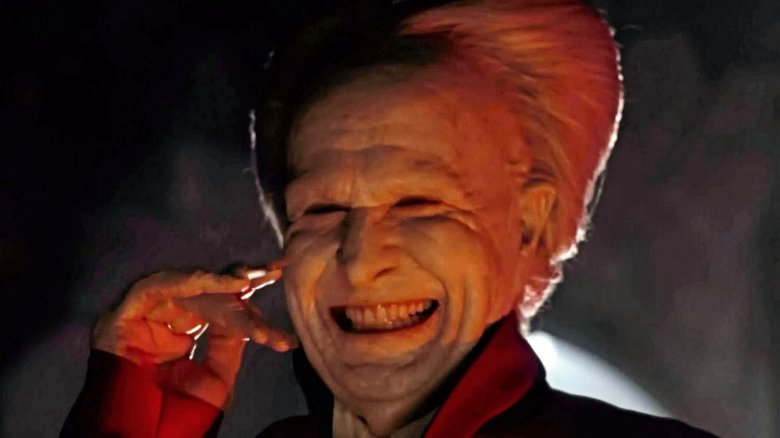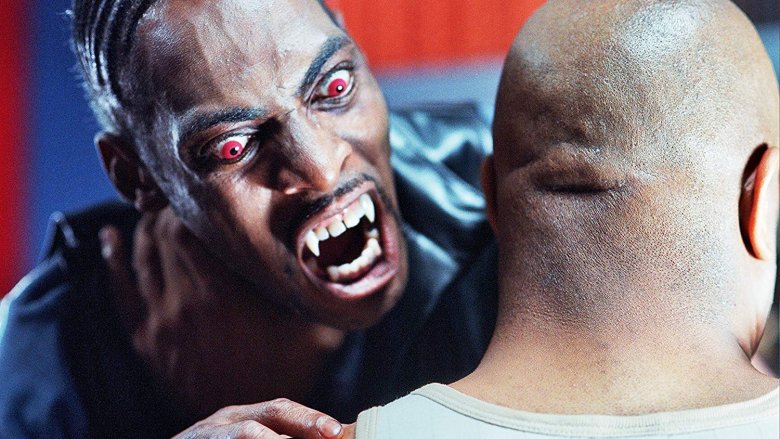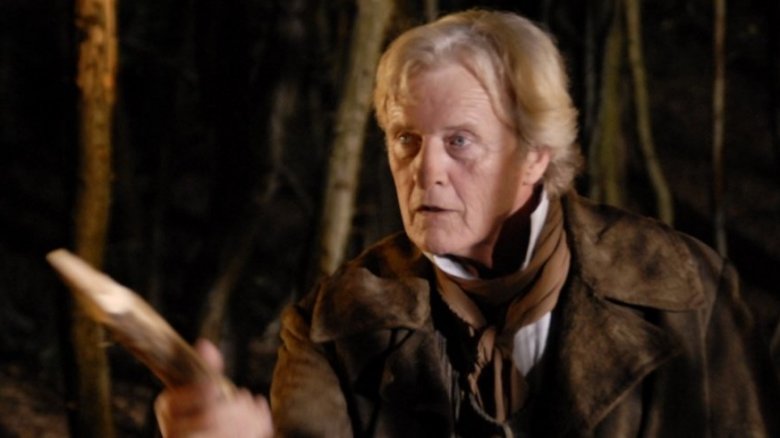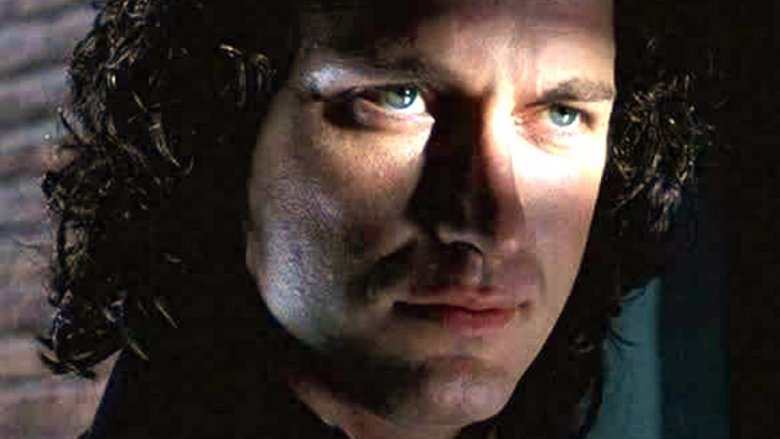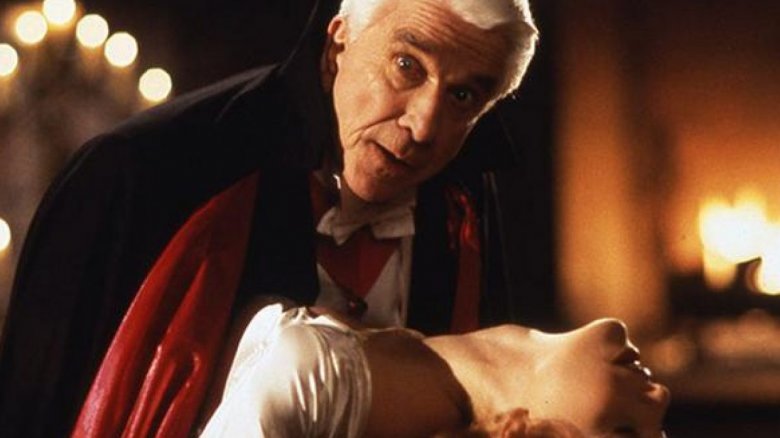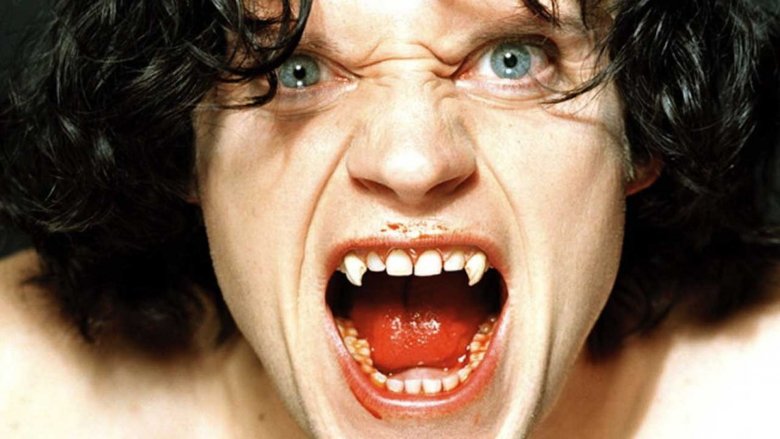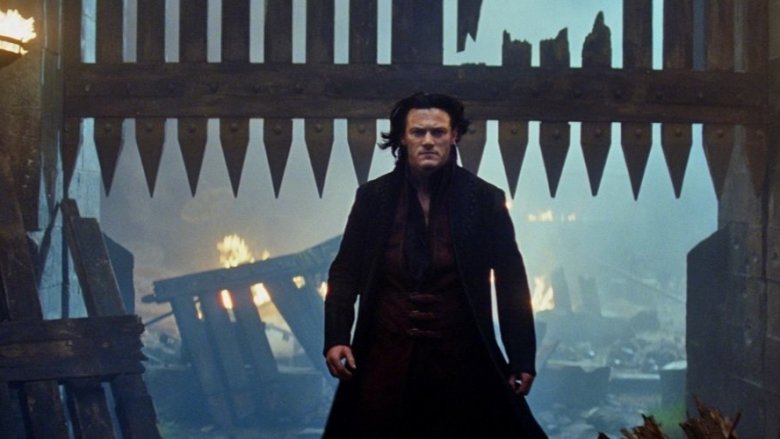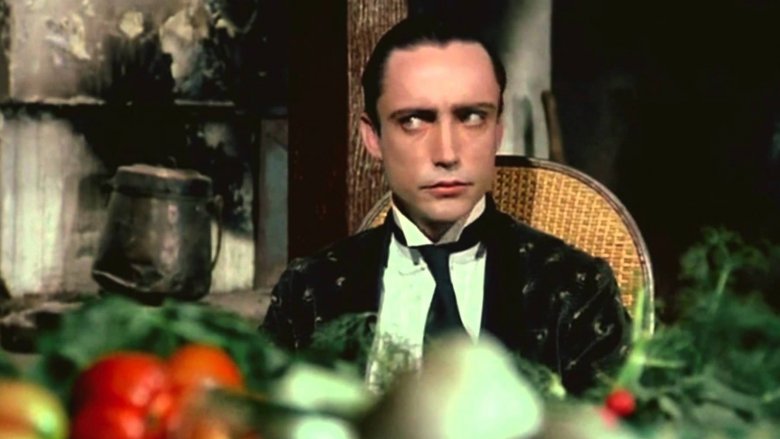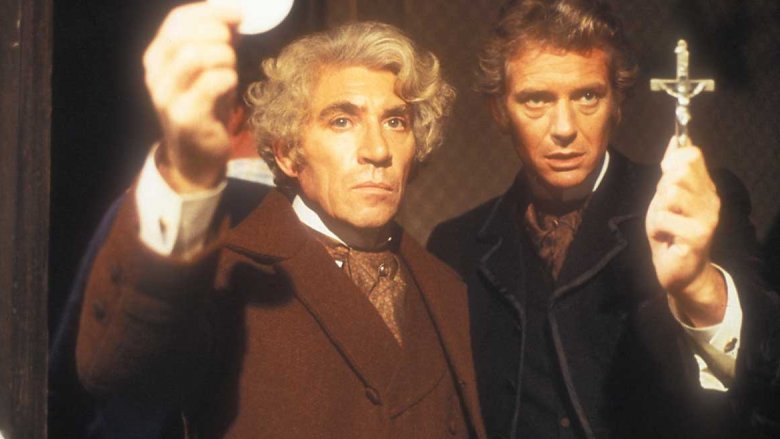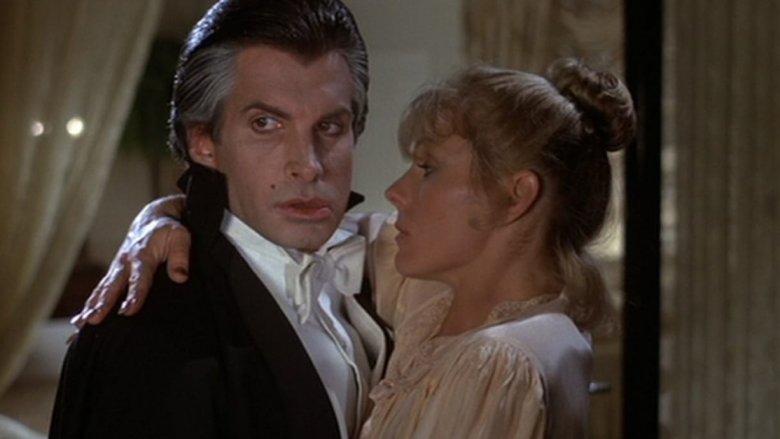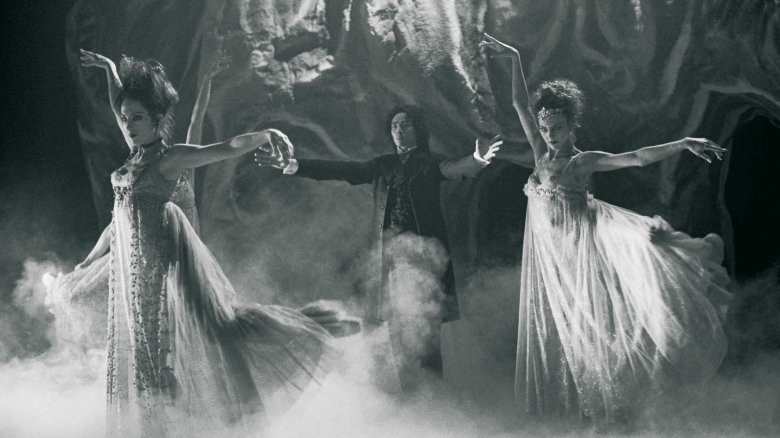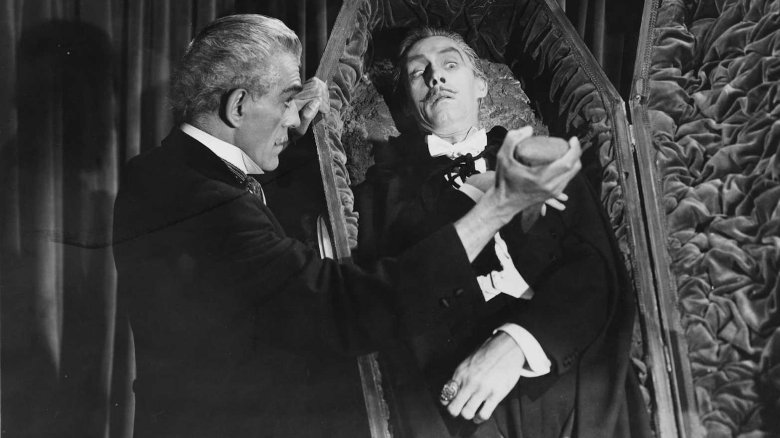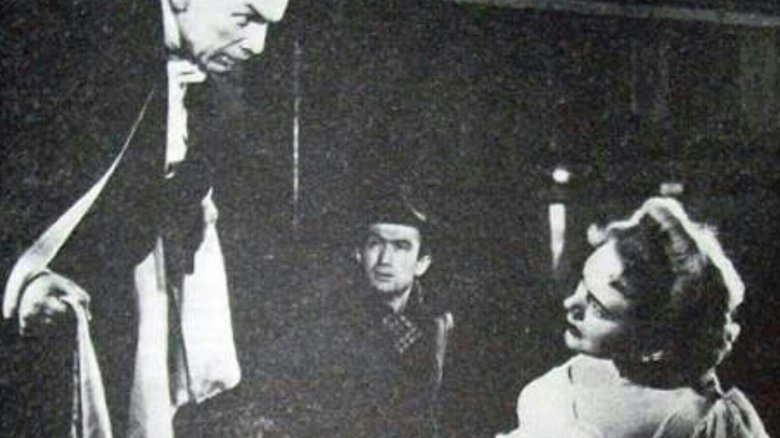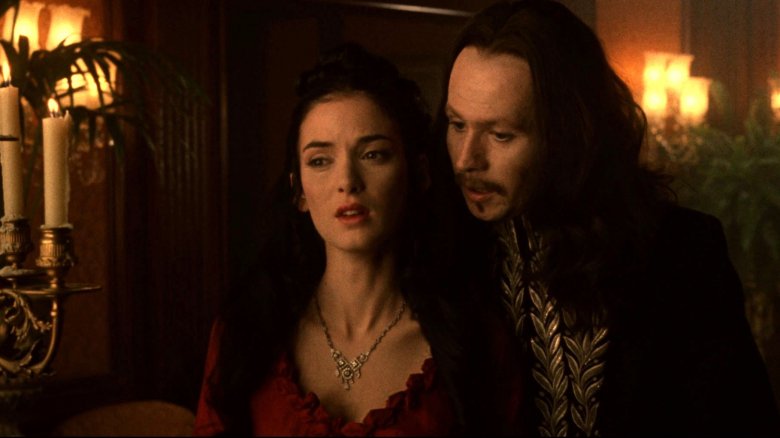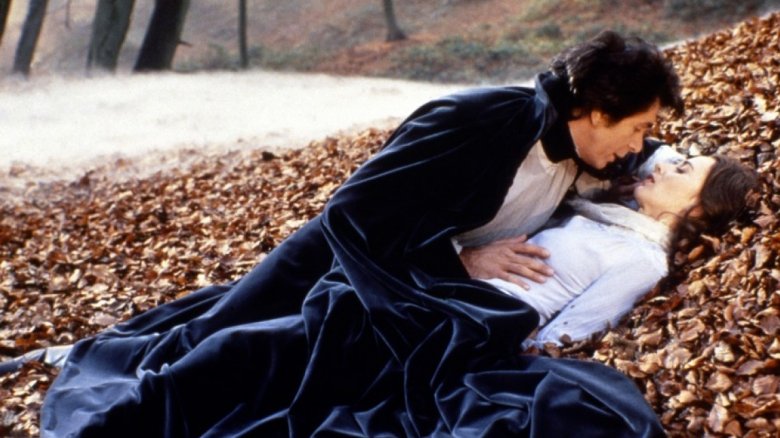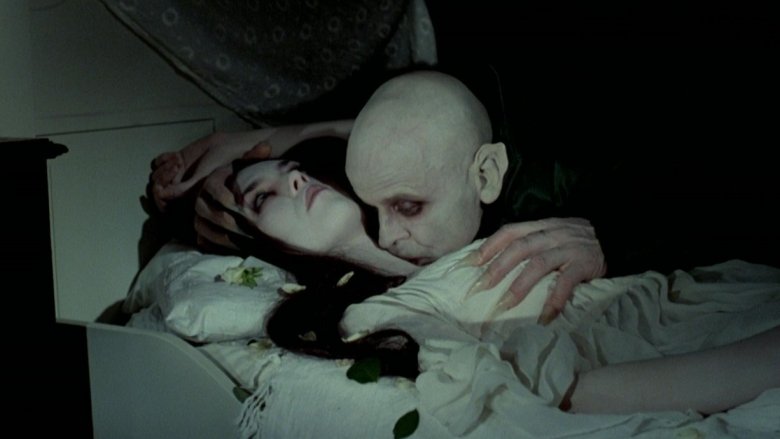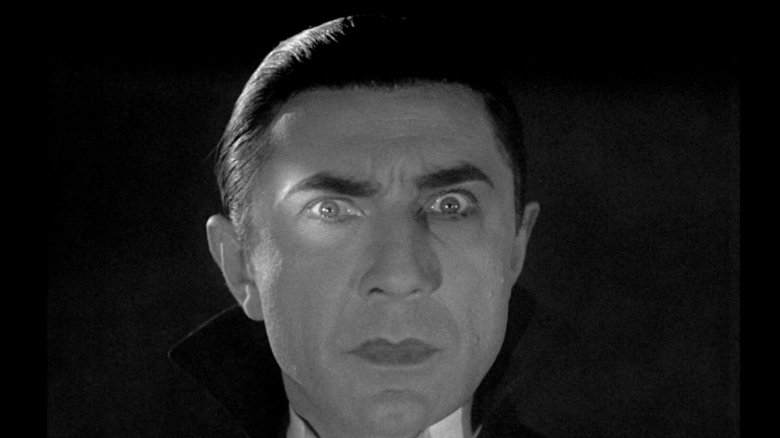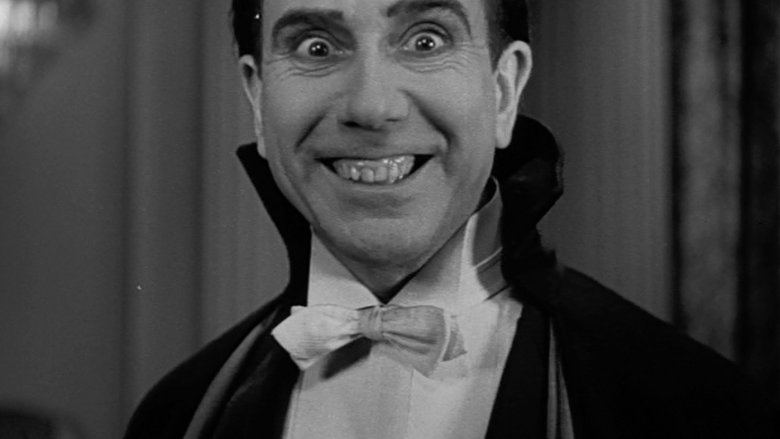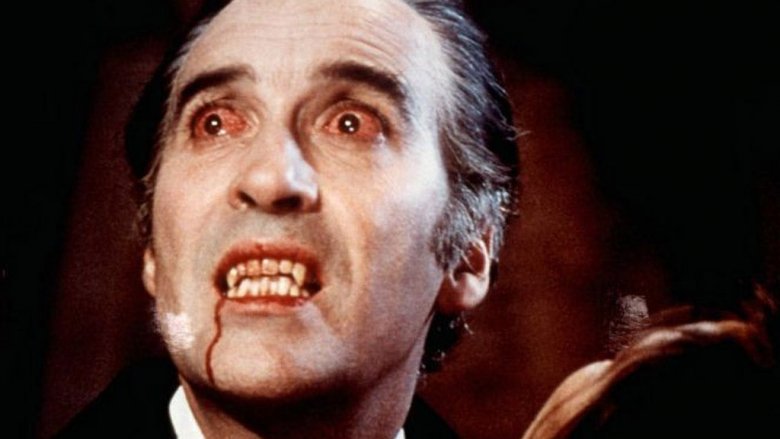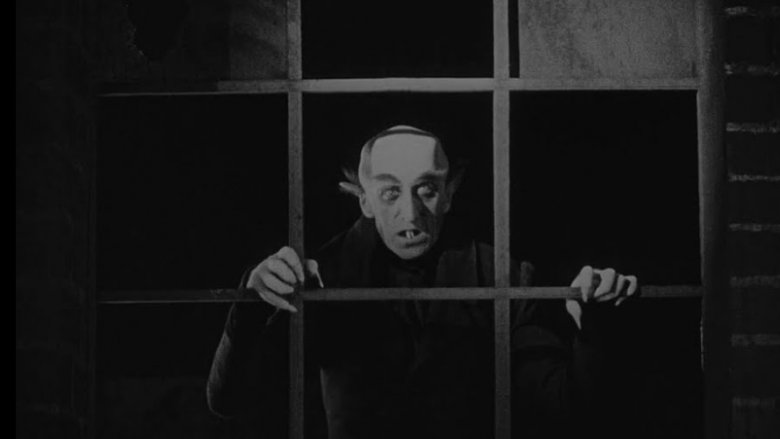Every Live-Action Movie Version Of Dracula Ranked Worst To Best
'Tis late in the eve and thy lights are all low, babes tucked away rocking hither and fro. Yet something doth stir in the back of thy mind, a ghost from a long day of scrolling and swipes. So ye go from thy bed, set thy screen all aglow, and into a hole dug from mouse clicking thy go.
Thy first click on that and then click on this, on websites that swing, and on websites that miss. Thy stumble on "Great things to see in Milan," then on "Ten facts about the saber-toothed mastodon." And somewhere between giant cats and church spires, a hunger does grow for films of vampires.
So rise and come close, don thy colors of night, paint thy mouth red as rose, and thy cheeks ghostly white. Forthwith we'll delight in the lurid and bleak, in the ghouls and the fiends that doth hiss and doth shriek. Steel thy nerves lest ye tremble and perish from fear — and rejoice, for the ranking of every movie version of Dracula is here!
Dracula 3000
Since 1902's Voyage dans la Lune, filmmakers have been shooting people into space. From Josie and the Pussycats to Danny Trejo's Machéte, many memorable characters have reached for the heavens in search of vengeance, adventure, or a chance to start anew. But as both characters and audiences of Dracula 3000 might tell you, sometimes space kind of bites.
Set in the year 3000 (hence the title), the movie follows a group of space salvagers led by one Captain Van Helsing. The fun begins when the team comes across a derelict ship called the Demeter, and Van Helsing decides to keep it. But not after finding the previous captain dead, tied to a chair, and clutching a crucifix, as well as a closet full of shiny sand-filled coffins (Craigslist sure is sketchy in the future). Before the crew can begin to drag the poor guy's space crypt back to earth, their ship mysteriously decouples, leaving them stranded without any chance of rescue.
Van Helsing and friends soon learn that the Demeter has a small vampire problem, with the source being none other than Count Orlock, better known as Nosferatu, the first (unauthorized) movie Dracula. As one would expect, this is where all the running, screaming and bleeding starts, but while both vampires and space are exciting and terrifying on their own, Dracula 3000 winds up being neither, instead leaving audiences with one of the worst ripoffs of Alien (which is truly saying something) and the single worst Dracula movie.
Dracula 3D
3D cinema, like the locust, seems to appear in cycles. After a period of dormancy, sometimes decades long, the plague appears again to feast, ravenously, unsparingly, before slipping away for another long nap. So it was when in 2012 Dracula 3D premiered amidst yet another vogue period that saw 3D chewing its way into every corner of the industry. But while Dracula 3D's release followed proven viability for 3D in the horror genre with then-recent films such as My Bloody Valentine 3D, cult director Dario Argento's effort seems hellbent on eroding any audience faith in the technology.
Dracula 3D is rough. Soap opera-style camera work and low-quality 3D are paired with even lower quality CGI. And if bad visuals weren't enough of a detriment, there's also the acting. The film also manages to stay just close enough to Bram Stoker's novel to thoroughly garble it, as though the screenplay were adapted through a game of Telephone. A handful of those present at the premiere noted that the film sometimes teeters on the edge of so bad it's good, and maybe someday changing audience perception will tip it over that edge. For now, though, Dracula 3D remains one of the worst Dracula films ever made.
Dracula 2000
The late Wes Craven's often pioneering and typically exquisite work as a writer, director and producer of slasher films earned him the title "the Master of Horror." But in addition to being responsible for Nightmare on Elm Street, Scream, and The Hills Have Eyes (the 1977 original), Craven also unfortunately hitched his name to a few complete flops. Dracula 2000 is easily one of the most embarrassing examples. As was a frequent plot device at the turn of the millennium, Dracula 2000 sought to take a classic character (guess who) and pull him into the sleek and sexy 21st century. While vampires typically live forever, Dracula would probably have been better off dead.
As parodied in the criminally under-appreciated comedy Hamlet 2, creating a modern-day sequel to a literary classic is inadvisable. Craven and creator-director Patrick Lussier would've been wise to heed this unspoken rule, but instead decided to pretty much do everything it aims to prevent, complete with a time-traveling (sort of) Van Helsing. Despite the absurd plot and mostly anemic acting, critics were actually somewhat forgiving of this corpse-like revival of Stoker's classic. Positives include Gerard Butler (of 300 fame), who does a pretty decent Dracula, and to some, the ridiculous story is enough to make the film at least watchable.
Dracula: Dead and Loving It
The line between horror and comedy can sometimes be razor thin. Filmmakers can do a lot with this dichotomy to interesting effect (see Shaun of the Dead), but parody is by far the most common intentional interplay between the two. However, while a bad horror film can be funny, bad parody is usually just bad. Dracula: Dead and Loving It almost goes one step further into actually becoming depressing, mostly because it's not only one of Mel Brooks' weakest films, but also his last.
Dracula: Dead and Loving It could've been the amazing spiritual successor to one of Brooks' best and most loved films, Young Frankenstein. Most of the cast, like Brooks, were veterans of Hollywood comedy who should've been more than capable, and of course the source material — the 1931 Dracula starring Bela Lugosi — is ripe for parody. Somehow, like most of Brooks' later films, the ingredients just didn't quite come together. Thankfully, Mel Brooks' other films aren't going anywhere, and there are plenty of other vampire films with comedic value, even if some of them weren't meant to have any.
Dracula (2007)
Dracula fans will be forgiven for missing this lesser known production co-created by WGBH Boston and BBC Wales. For those paying attention, yes, that means it was a made-for-TV movie, and yes, it was also produced for public television, which for many is truly scary indeed. Rest assured, It's safe to keep reading, but keep that spritzer of holy water handy.
For those not afraid of public television, Masterpiece Theatre should sound familiar, having been responsible for some truly incredible literature and biography adaptations, and perhaps most famous for being behind the period original Downton Abbey. From a production perspective, Dracula pretty much fits right in, with great actors and a beautiful, meticulously period-correct world for them to play in. However, in contrast to the series' reputation for faithful recreations, Dracula takes a few creative liberties, such as omitting certain well-known characters and introducing a more explicit disease subplot. Sadly, the changes, though novel, do more to alienate fans than give the story new life. Overall the film struggles to find its voice, landing somewhere between typical Masterpiece artistry and something closer to a popcorn-flick throwaway, while largely missing the best bits of both.
Dracula Untold
Long before the Marvel Cinematic Universe, Universal invented the very notion of a shared cinematic universe with some of its classic monster movies. When it came time for the studio to try wresting away some of Disney's cornered market (as all have tried), it only made sense to go back to their roots with the Dark Universe. Dracula Untold was meant to be the first of the series, and as the name suggests, the film tells a Dracula story that hadn't been shown onscreen.
Dracula Untold is a fantastical retelling of the life of Vlad the Impaler, the historical figure long been believed to be Bram Stoker's inspiration for Dracula (though some contemporary experts suggest Dracula was more likely based in Irish history and folklore). In the story, Vlad acquires his vampirism after striking a deal with a vampire — the latter having acquired it from a demon's curse — so he can protect his family and kingdom from the ruthless Ottoman empire. Despite an intriguing historically based backstory with breathtaking production value, Dracula Untold wandered too far into action-fantasy, and overall just wasn't especially memorable or special. After 2017's The Mummy fared even worse, the Dark Universe seemed to have turned to dust, but it too may yet return from the dead.
Blood for Dracula
Andy Warhol is pretty much a household name, and where the artist isn't known, his work most certainly is. But while most people have seen his famous silkscreens, most probably aren't aware of Warhol's film career. And really, that's completely understandable, because while Blood for Dracula and its companion film Flesh for Frankenstein were both advertised under Warhol's name, no one has ever figured out what exactly he contributed to either. Despite the billing, the film was written and directed by Paul Morrissey, a friend of Warhol known for his experimental filmmaking.
The story is a violent and sexually explicit pseudo-parody of Bram Stoker's Dracula, in which the titular character must only feast on virgin blood and is dying due to a lack of virgins in Transylvania. After relocating to a heavily Catholic area of Italy, hoping to have better luck with his virgin problem, the vampiric lord enters into a deal with a wealthy estate owner to marry one of his four daughters, all of whom are supposed virgins. Hijinks ensue (some of which are deeply problematic) in what is undoubtedly one of the single most bizarre narrative films ever made. But Blood for Dracula has since gained a cult following, precisely because of just how strange it is.
Count Dracula
Like 2007's Dracula, Count Dracula was a made-for-TV film produced by the BBC. With period accurate sets and costumes, the film offers a believable lens into the time when the story takes place. Thanks to excellent acting, and a notable adherence to the source material, it's also a window in to the world Bram Stoker created. At the time it was produced, Count Dracula was quite easily the most accurate dramatization of Stoker's original work, not only following the plot closely, but also allowing room for each of the characters to develop, giving each the weight and involvement originally intended for them.
Unfortunately, unlike its 30-year-younger successor, Count Dracula does show signs of its age. Many will be charmed by the camera and editing work, which is quintessentially 1970s British — as is the music, which is only marginally too dramatic for its own good. The special effects, on the other hand, despite being used sparingly, sharply blemish the film, even alongside comparably produced contemporaries like Doctor Who. Audiences that become easily distracted by cheesy color and image overlays might want to skip this one, as will those wanting something truly scary; fans of classic literature and cinema, on the other hand, will appreciate Count Dracula's attention to detail, old-school theatricality, and charisma.
Love at First Bite
Picture this: You're more than a hundred years old, living in a manor you've owned since before the advent of sliced bread. You may murder here and there to sustain your life force, but otherwise keep to yourself. Then one day the government shows up at your giant castle door and takes it all away. Why? Because some gymnasts need a new facility, and this is Communist Romania. What's an exiled immigrant vampire to do? Move to New York, of course!
In the 1972 horror-comedy Love at First Bite, starring George Hamilton in the central role, Dracula does just that. After learning about the wonders of the new world (Blood banks! Free love! Discotheques!), Dracula makes the big move across the Atlantic. He meets a beautiful model named Cindy (Susan Saint James), who he believes to be a reincarnation of his long-dead lover. Unfortunately she has a boyfriend who just so happens to be the grandson of none other than the original Dracula hater, Van Helsing. Like a vampire-laden Shakespearean farce, Love at First Bite is an excellent addition to the Dracula lexicon because of just how different it is from any Dracula film. It was well-received by audiences at the time (though not always by critics), in large part because it was one of the first Dracula films to nail the vampire humor. Years on, the jokes don't always fly, but overall it's a sweet and funny take on Drac's whole bloodlust conundrum that for some will certainly hit the vein.
Dracula: Pages from a Virgin's Diary
Before Bram Stoker's novel even hit shelves, the novelist himself created and directed its first theatrical adaptation, which is to say that the story has had a long life in the dramatic arts. While many of the character's best films have come directly from this tradition, Dracula: Pages from a Virgin's Diary takes this a step further, by blurring the lines between narrative film and filmed ballet.
The story was adapted by the Royal Winnipeg Ballet and directed by Guy Maddin, who chose to produce the performance as if it were any other film, utilizing close-ups and editing techniques more common to mainstream cinema than theatrical documentation. Additionally, Maddin shot it much like his other work, in the style of a silent film: black and white, featuring dialogue cards, and even going so far as to reproduce 1920s practical effects. As for the ballet itself, the material is considered one of the most faithful to Stoker's original work, but while others have emphasized themes of sexuality or disease, among others, Maddin chose to emphasize xenophobia, hammering the point home by casting the phenomenal Chinese actor Zhang Wei-Qiang as Dracula. Dracula: Pages from a Virgin's Diary is an odd bird, but it's also easily one of the best Dracula films ever made.
House of Dracula
In 1944, Frankenstein's monster (Glenn Strange), the Wolf Man (Lon Chaney, Jr.), and Dracula (John Carradine) got together for a little terror party at Frank's in House of Frankenstein. Full of murder, mayhem, and of course, romance, House of Frankenstein was received well enough for Universal Pictures to get the band back together in 1945's House of Dracula. After learning of a Mad Doctor (Onslow Stevens) with the cure for vampirism, Dracula flies himself over to Vasaria to pay him a visit. Meanwhile, Lawrence Talbot (a.k.a. the Wolf Man) arrives looking for a cure himself. As Dracula waits for his procedure, the Wolf Man and the Mad Doc form what might be called a friendship, which culminates in the pair discovering Frankenstein's monster in a cave, cradling the skeleton of the late Dr. Neimann (from House of Frankenstein).
While Wolf Man and the Mad Doc bond, Dracula decides to turn one of the doctor's assistants, Milizia, into his new undead bride. An epic fight between the Wolf Man and Dracula ensues, and the rest is best left unspoiled. Pure monster supergroup wish-fulfillment aside, what makes House of Dracula so appealing is Carradine himself, who makes for a very fine Dracula. Menacing and charming, he's seductive enough to draw you in, and spooky enough to creep you right back out. This proved the last time any of the legendary monsters would grace the screen for many years, but it wasn't a bad way for the band to break up.
Drakula İstanbul'da
Istanbul, Dracula's coming for you. Or at least he was in the 1953 Turkish feature Drakula İstanbul'da. Also known as Dracula in Istanbul, the film is another based on Bram Stoker's novel, but by way of a 1928 translation by Ali Riza Seyfi. Though at first glance Seyfi's book appears to be a straight translation, the novel is actually missing several characters (including Renfield), and changes key traits of certain others. Mina Harker's character, for instance, is renamed Güzin and written as a showgirl. The novel and film also make a point to connect Dracula to his alleged historical inspiration, Vlad the Impaler.
Changes aside, the film follows Stoker's beats fairly faithfully. It follows a lawyer named Azmi (Johnathan Harker) who travels to Romania from Istanbul to handle a case. He learns of an evil force called Drakula, pays it no mind, but eventually winds up in the Count's castle and clutches. The rest is literary history. For those few who've seen it, Drakula İstanbul'da is a true favorite. Despite a lower budget than many of its Western contemporaries, the film still manages to scare, creating an effectively spooky atmosphere. It's also worth noting that Drakula İstanbul'da was the first true Dracula film to feature the now-iconic vampire fangs. This refreshingly different take on Dracula is well worth hunting for.
Bram Stoker's Dracula
If one were to dream cast an adaptation of Bram Stoker's novel using actors from the '90s, they might just come up with the impressive ensemble that graced 1992's Bram Stoker's Dracula. Directed by Francis Ford Coppola, the film stars Gary Oldman, Winona Ryder, Anthony Hopkins, and Keanu Reeves (in what some consider a fairly terrible performance). It also features incredible turns by character actors such as Richard E. Grant, Cary Elwes, Sadie Frost, and even Tom Waits.
Following decades of campy B-movie relegation, Bram Stoker's Dracula was lauded for bringing a sense of gravity back to the story. Instead of putting the bloodsucker into yet another strange happenstance, the film looks back to the source material and emerges with a gothic romance. Coppola insisted that all visual effects were done practically, even going so far as to fire the entire VFX team. The film altered the aesthetics of vampire movies for years to come, inspiring a new generation of representation for the creatures of the night that can be felt today. Though there was some on-set drama, (everything from terrifying makeup to an accidental marriage), it didn't bleed into the end result, which still stands as one of the best vampire films of all time.
Dracula (1979)
Nearly 20 years before Coppola threw his hat in the vampire adaptation ring, John Badham directed Dracula in 1979. Like Coppola's version, Badham's Dracula leaned into the romantic aspects of the novel, going so far as to make its tagline "A Love Story." Unlike the 1992 Dracula, this adaptation pulled more from the 1924 stage adaptation, in which Abraham Van Helsing (Laurence Olivier) investigates a mysterious illness that leads him directly to Count Dracula himself. As in the play, the film features a sick Mina van Helsing (Jan Francis), who meets Dracula (Frank Langella) and invites him over for dinner (a clear rookie mistake). When Mina mysteriously dies, Van Helsing is brought in to investigate.
One of the most striking things about the stage adaptation is that it was designed by Master of All Things Spooky Edward Gorey. The film, while not designed by Gorey himself, has echoes of the stage play's design, including a beautiful glass matte painting of the Castle Dracula, painted by Albert Whitlock. It's full of creeping shadows and gloomy corridors that seem to ache as the characters descend deeper into Dracula's madness. It's so effective in its mood-building, it's still highly regarded today. Unlike other versions of the character, Langella saw Dracula as a heartless, charmless creature, completely detached from humanity. As such, the love story in the film is intense, both to its benefit and detriment, but there's no denying that Langella's performance is one for the ages.
Nosferatu the Vampyre
The same year Frank Langella and Laurence Olivier faced off in the 1979 Dracula, international delight Werner Herzog released Nosferatu the Vampyre. Unlike other adaptations, Herzog's film was a direct adaptation of the original Nosferatu and as such, aesthetically breaks from most modern Dracula renditions. Gone are the perfectly slicked-back black hair and the dashing red cape. Instead, Klaus Kinski's Count Orlock dons a simple black garb — high-collared, long-sleeved, and beautifully creepy. His scalp is bald, his pointed ears prominent, dark circles sit under his eyes, and rodent-like incisors hang from his mouth. A far cry from the romantic idealized version of Dracula popularized by Universal Pictures, Noferatu the Vampyre is truly the stuff of nightmares.
And yet, like most Dracula stories, Nosferatu the Vampyre is, at its heart, a romance. When the Count falls in love with the portrait of a young Lucy (Isabelle Adjani), he moves in next door. When it turns out Lucy is more interested in regular human men like Jonathan Harker (Bruno Ganz), Orlock is a little less than pleased. When Lucy discovers that the string of deaths in her hometown (previously attributed to diseased rats) is actually Orlock's doing, she's even less pleased. An animal cruelty scandal aside, Herzog's Nosferatu is a haunting film, driven by the director's singular perspective and striking directorial eye. Thanks to the film's strong production value, some may even prefer it to the original.
Dracula (1931)
Bela Lugosi's dead, but his legacy lives on thanks in large part to his utterly devastating turn in the 1931 film Dracula. Regarded by many as one of the best vampire films of all time, if not the best, Tod Browning's adaptation is almost single-handedly responsible for the vampire films audiences enjoy today, with its intense and moody atmosphere and pitch-perfect casting. Lugosi was so adept at the part thanks to his years of experience playing it onstage, though that didn't stop Universal from almost not casting him. Thanks to the hands of fate, audiences were introduced to his singular presence, and Lugosi's legacy continues to this day.
The film itself is often regarded as a classic of cinema, horror or otherwise. The story is derived primarily from Bram Stoker's book, but it also pulls scenes from the early film Nosferatu that never appeared in the original text. Though the cast outside of Lugosi is regarded as fairly mediocre, the film boasts luscious cinematography and is held together by the sheer power of the star's presence.
Drácula
During Hollywood's early days, studios were determined to get maximum bang for their buck. Sometimes this meant shooting the same film twice, but in a different language, as is the case with the Spanish-language version of the 1931 Dracula, titled Drácula. Shot on the same sets on opposite work schedules, Drácula was long forgotten in the greater lexicon of Dracula films — despite it being just as good, if not better than, its English-language counterpart.
Though they hit most of the same narrative beats, Drácula is much more visually dynamic. Where Tod Browning's film relied heavily on its star power and cinematography, director George Melford's style was much less static. The crew also benefited from having the English language dailies to build off of, learning from and building upon them (though star Carlos Villarías was allegedly encouraged to recreated Lugosi's performance as closely as possible). The film is also longer, allowing more time for character development than Browning's version.
Though it vanished for many years, a copy surfaced in the 1970s, illuminating the world to a glorious parallel universe. On October 25, 2015, Drácula made its official theatrical debut as a part of Turner Classic Movies' "TCM Presents" series (a double feature with the English language version), and redefined Dracula history forever.
Horror of Dracula
Outside of the legendary Bela Lugosi, the late and literally looming Christopher Lee is easily one of the best Draculas of all time. Lee made his debut in the highly regarded 1958 Horror of Dracula, which spawned a nine-film franchise. The film features Peter Cushing as Dracula's ever-present foe Van Helsing, as well as Melissa Stribling, Carol Marsh, and Michael Gough. Like many of the other Dracula films, Horror of Dracula largely adheres to Bram Stoker's original text. Unlike many others, Horror of Dracula's story lives up to its stellar cast, thanks to a well-crafted script from screenwriter Jimmy Sangster.
Because it is so well-written, all of the other elements of the film are elevated. Director Terence Fisher creates the requisite mood, and the capable cast flushes out the material beautifully, especially Cushing, who is arguably the best film Van Helsing to date. Visually, Horror of Dracula established many of the modern flourishes expected from a vampire film: prominent fangs, glowing red eyes, pre-made wooden stakes. Through it all, Lee — like Lugosi before him — towers over the film, oozing charisma and terror in equal measure while playing off his talented castmates. It solidified Lee as a force to be reckoned with, though like Lugosi before him, also resulted in industry typecasting for much of his career because casting directors couldn't see him as anything other than Dracula. Unlike Lugosi, Lee eventually broke from Dracula and is remembered for an illustrious career.
Nosferatu
Over Dracula's hundred-plus year history in cinema, the character and his story have inspired some truly amazing films. Yet, while each one has brought its own original ideas and artistry to the great Dracula tapestry, all owe a great debt to the 1921 classic Nosferatu — the single oldest Dracula film, and among the earliest horror films in general. Not only did the production introduce a wider audience to the character, and vampire mythology, it also created a tone for cinematic horror that continues to reverberate through the genre. Simply put, Nosferatu is a landmark for Dracula, horror, German expressionism, and film history as a whole. The great irony, as fans are aware, is that Nosferatu, the best Dracula film ever made, had to pretend it wasn't actually a Dracula film. Wie bitte?
The story goes that Albin Grau, occult enthusiast and co-founder of the studio behind Nosferatu, got the idea to produce a vampire film. Grau commissioned screenwriter Henrik Galeen to pen a production based on Bram Stoker's novel, which contemporary literary critics gushed over for its poetry and rhythm. But when the Stoker estate refused to grant permission to the production company, the script was reworked to avoid copyright infringement. It didn't work, and the studio filed for bankruptcy soon after the film's release. All copies of the film were to be destroyed by a court order, but thanks to international distribution, Nosferatu survived. So has its ability to linger — hauntingly, agelessly, like Dracula himself.
